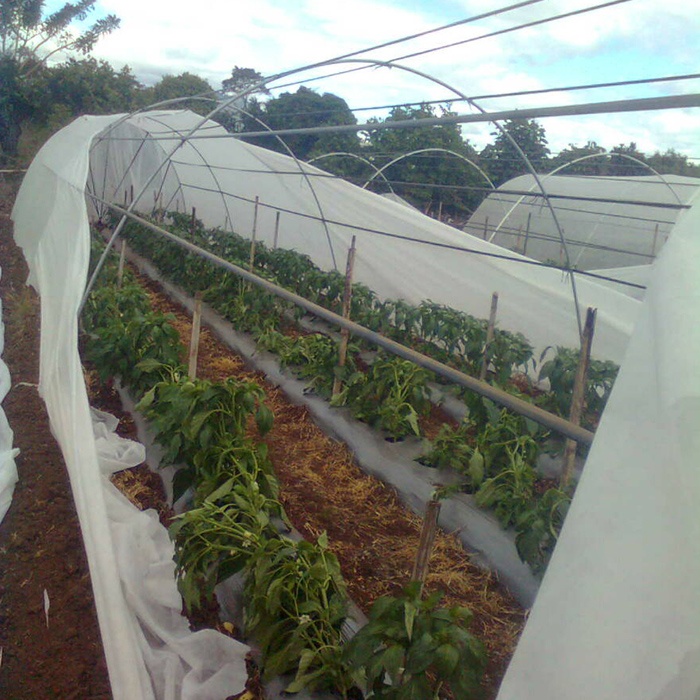The performance characteristics of agricultural nonwoven fabric: it has the functions of heat preservation and energy saving, frost and frost prevention, humidity and disease prevention, shading and dimming, insect control and weed avoidance. Water resistant, light resistant, breathable, light weight, easy to operate; No gas release when burning, not easy to bond and easy to keep; Resistant to corrosion and deformation.
Heat preservation: because the transmittance of non-woven fabric to long-wave light is lower than that of plastic film, and the heat dissipation of the night radiation area mainly depends on long-wave radiation; Therefore, it can increase the temperature of greenhouses, greenhouses and soil and have the effect of increasing production and income. The average temperature increase of surface temperature is nearly 2℃in sunny days and about 1℃in cloudy days, especially when the temperature is low at night, the surface heat radiation is significantly weakened and the insulation effect is better to 2.6℃, but the insulation effect on cloudy days is only half of that on sunny nights.
Whether the temperature in the ground is sunny or cloudy, 20 grams per square meter of non woven fabric cover has warming effect; However, the effect of sunny days is better than that of cloudy and rainy days, and the warming effect of shallow soil layer is higher than that of deep soil layer. The warming effect of non-woven cloth cover covers more than 20 cm of soil layer. For example, the leaf temperature of lettuce cultivated in the open field increased by 3℃at noon, and the temperature was still 0.65~0.75℃even in the cooling stage at night.
The increase of leaf temperature is very beneficial to the growth of winter lettuce. In order to improve the night warming effect, the leaf surface of the plant should not be close to the mulch. Field observation found that at the extreme minimum temperature, 20 grams of non-woven fabric per square meter can be warmed up to 3.8 degrees at -7.2℃. Moisturizing: the pores of non-woven fabric are large and soft, and the fiber gap can absorb water. It can reduce the relative humidity of the air by 5%~10% to prevent condensation and reduce the occurrence of diseases.

According to the soil moisture content measured after covering, 25 grams per square meter of staple fiber non-woven fabric and 40 grams per square meter of spunviscose non-woven fabric has the best moisture retention; The water content was increased by 51.1% and 31% than that of uncovered land, respectively. Light transmission: has a certain light transmission, the thinner the non-woven fabric light transmission is better; The thicker it is, the less transparent it is. The transmittance of 20 and 30 grams per square meter is the best, reaching 87% and 79% respectively, which is similar to the transmittance of glass and polyethylene agricultural film.
Even 40 grams per square meter or 25 grams per square meter (short-fiber hot-rolled non-woven fabric) can reach 72% and 73%, respectively, to meet the light needs of cover crops. Breathable: non-woven fabric is composed of long filament interlayed into a network, with high porosity breathable; The size of air permeability is related to the gap size of non-woven fabric and the temperature difference inside and outside the covering layer, wind speed, etc.
General short fiber than long fiber ventilation rate is several times higher to 10 times, no wind condition 20 grams per square meter of long fiber non-woven fabric breathable rate of 5.5 to 7.5 cubic meters per square meter per hour. Shading and cooling: covered with colored non-woven fabric, can play the role of shading and cooling. Different colors of non-woven fabric shading, cooling effect is different. The shading effect of black non-woven fabric is better than that of yellow, and yellow is better than blue.
Anti-aging agricultural non-woven fabrics have generally been anti-aging treatment, the thicker the cloth strength loss rate is lower. Non-woven suitable crops, not only suitable for vegetable winter and spring seedling cultivation, early and delayed cultivation, summer seedling cultivation and shade cultivation, but also can be used for flower, rice, tea and other cover cultivation. Not only suitable for greenhouse, greenhouses for two curtain, three curtain, but also suitable for surface cover cultivation.
Winter and spring vegetables frost-proof, insect-proof, mainly used for spring radish, spring cabbage, spring potato, spring watermelon, spring cucumber and other open ground or shed floating surface cover, can prevent late frost damage and insect prevention, but also can promote growth, early harvest, increase production. Fruit and vegetable early cultivation, mainly used for solar greenhouse, greenhouse or small arch shed early spring planting zucchini, watermelon, melon, cucumber, tomato, etc.
In the early stage of planting, the non-woven floating surface is covered for 20 to 30 days to prevent frost, cold, heat preservation and insect prevention, etc., which can be removed immediately after spring warming (generally in early April) to promote early maturity and yield increase. Wintering vegetable antifreeze insulation, mainly used for wintering cabbage, spinach and other antifreeze insulation, with 20 grams per square meter of non-woven fabric as floating surface cover. Favorite friends collection and attention.
For more information on agricultural non-woven fabrics, please pay attention to us.










